Surprisingly, this concept is not limited to Hindu scriptures only. Even Islamic scriptures describe a paradise or a ‘Jannat’ full of gardens and pure perpetual virgins, who are divinely beautiful. Any righteous person would have an access to these most beautiful women or ‘Houris’ after his death as per these Islamic scriptures.
Khmer kings in medieval Cambodia, picked up this concept from Hindu Puranas and have given the Apsaras immortality by picturing the heavenly beauties in almost all temple bass reliefs in Angkor.
Another concept that was picked up by Khmer kings from Hindu Puranas was that of the God-King or of the king automatically becoming reincarnation of God once he takes over the throne. The concept of Apsaras well suited the God-King theory. Since the King was in any way, human Avatar of the God, he was surely entitled to have these celestial nymphs around him in the form of stone figures as well as real human females. Thus the King could maintain a large troupe of concubines in his harem.
Angkor temples have been built over a long period three or four hundred years (from 900 to 1300 A.D.) While visiting the Angkor temples, I realized that the Apsara figures are not at all repetitive. There is a wide variation in their physical features, faces, hair arrangement, crowns, earrings, necklaces, waistbands and the style of dressing. Some observers have noted that the reason for this variation is because the Apsara bass reliefs have been modeled from real life female concubines of the king from that period. If this idea is true then I thought that it might be interesting to compare the Apsara figures carved as bass reliefs all over this period. This might give an idea about the way the concubines looked and dressed.
Preh Rup Apsara
The oldest Apsara carving is from Preh Rup temple. This temple was built around 950 A.D. The Apsara figure in this bass relief is tall, slim and without any headgear or crown. She is not wearing much of jewelry either. The face is distinctly different from carvings in other temples. Banteay Strei Apsaras
Next Apsara carvings in the time line are from Banteay Strei temple. This temple was built around end of tenth century. The Apsara figures here do not wear any head gear again but appear to have done a hair-do or hair style. The figures are shown wearing ornaments. The designs of earrings, necklaces and the waistbands is rather intricate. The dress worn on lower part of the body is also different. Angkor Wat Apsaras
Perhaps the most detailed and extensive apparel and jewelry is seen on Apsara carvings from Angkor wat temple, which was built in the 12th century. Here they wear very tall crowns. In their hands intricately designed bracelets appear instead of bangles. The necklace design also has changed from usual choker type to a long necklace with a locket. The dress is worn in different style again. Earring and necklace designs here are rather exquisite. Ta Prohm Apsaras
The Apsaras from the Ta Prohm temple again are quite different. They have shorter and more plump physique. They have a hair style similar to Buddhist carvings. The designs of earrings and necklaces appears to be much simpler. This temple is from end of 12th century. The Bayon temple Apsaras wear a headgear which is very similar to Indian designs. They are shown to have long hair. The faces are again very distinctively different.
After having visited most of the Angkor temples, my initial reaction was that the bass reliefs could not have been modeled on real life human figures of that period. This was because the headgear and costume shown in the bass reliefs did not appear to be very practical. I could not imagine a real life person wearing such weird head gear and moving about. However, watching a performance of the famous Apsara dance from Cambodia, my doubts were soon dispelled. During Khmer days, this dance was performed only for the king and high officials of the court. However daughter of Prince Sihanouk (Born1922), Norodom Bolha devi was instrumental in popularizing the dance. In Pnom Penh, a dance academy today imparts training for the budding ballerinas in this classical dance. The ballerinas in this dance, wear similar headgear and costume to what is seen in the bass reliefs and are able to carry the attire effortlessly through dance movements. This more or less proves that the attire of Apsaras shown in Angkor temples is practical to wear.
Modern Cambodia continues with this fascination with the Apsaras. In one of the major street intersections in Siem reap, a huge Apsara statue has been recently installed. The semi official body, which looks after Angkor temples is named as Apsara Authority. On every street in Siem Reap, one can find at least one shop with a name which incorporates the word Apsara. As long as Cambodia exists, it seems that Apsaras would also stay in the imagination of the Cambodians.
4 February 2011

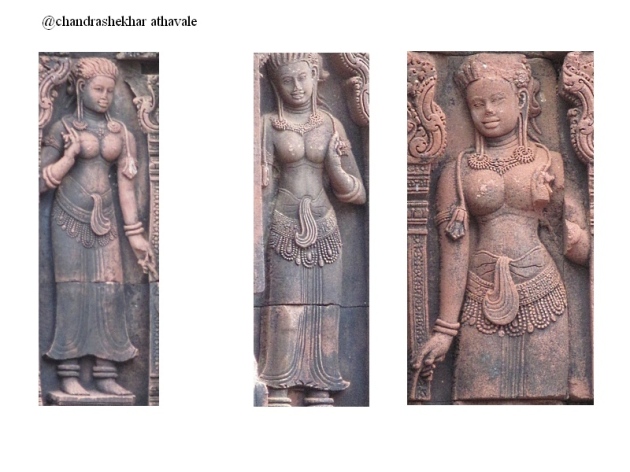

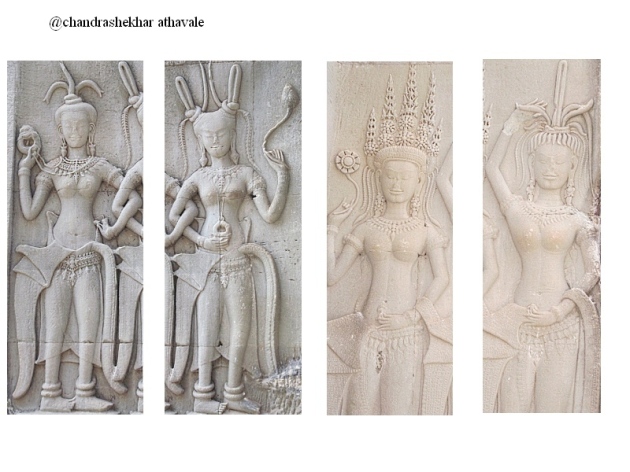
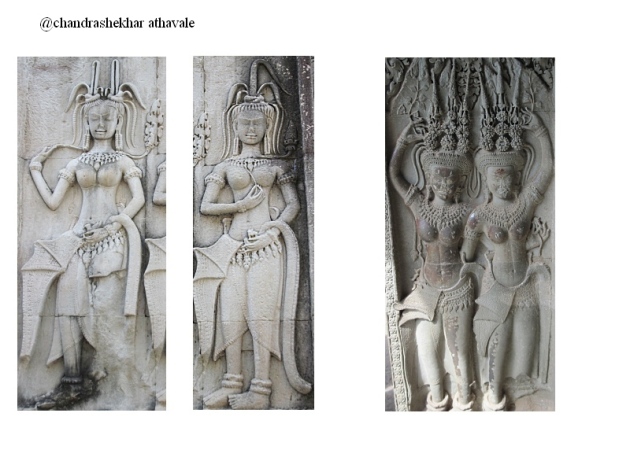
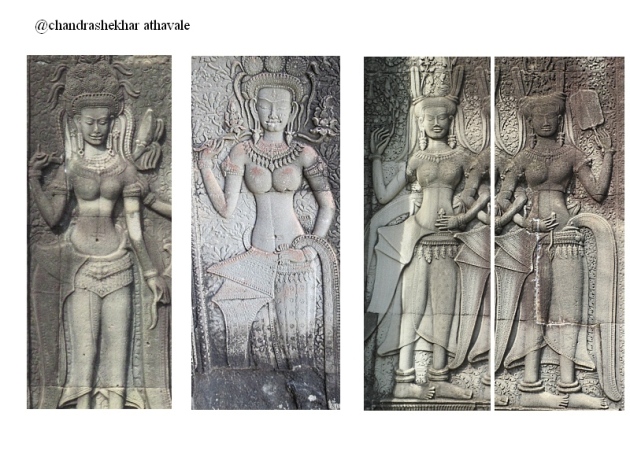

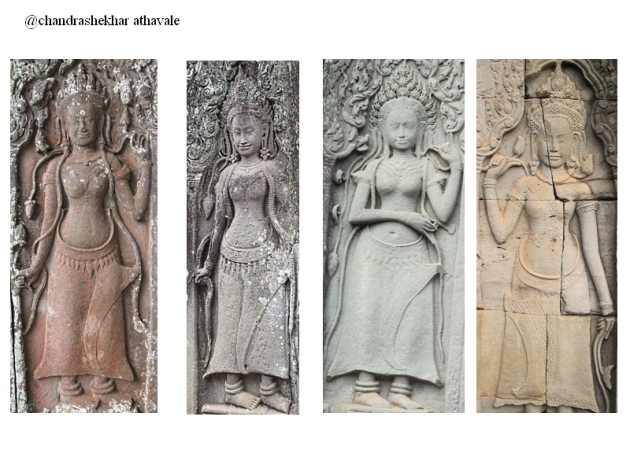

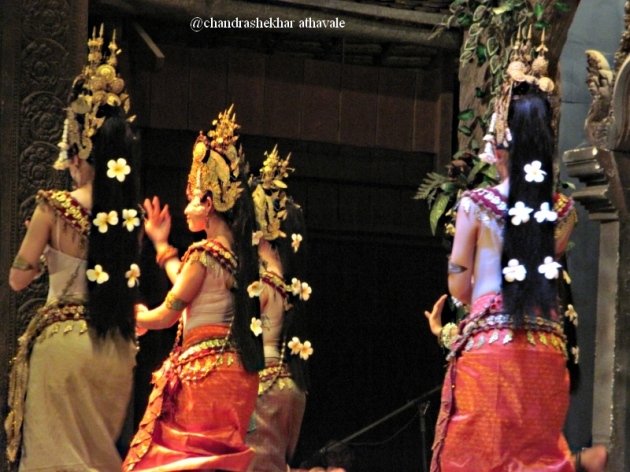

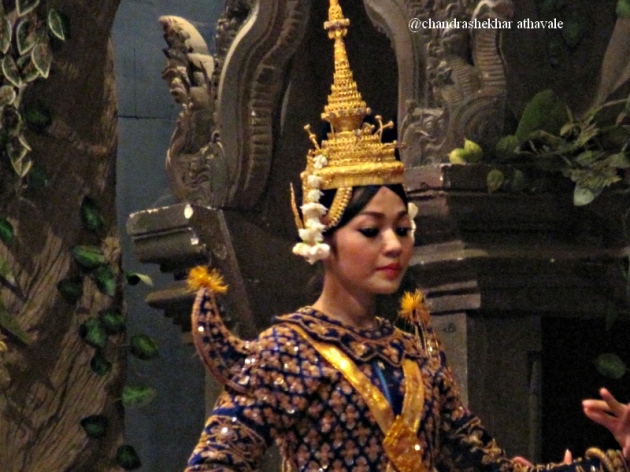
अप्सरा शब्दाची व्युत्पत्ती अप्सु जातः असी आहे. त्यावरून ही एक मातृसत्ताक जमात असावी असे वाटते.
ReplyDeleteReally a great work from you for the articles and the photos here...
ReplyDeleteDon't stop at all...